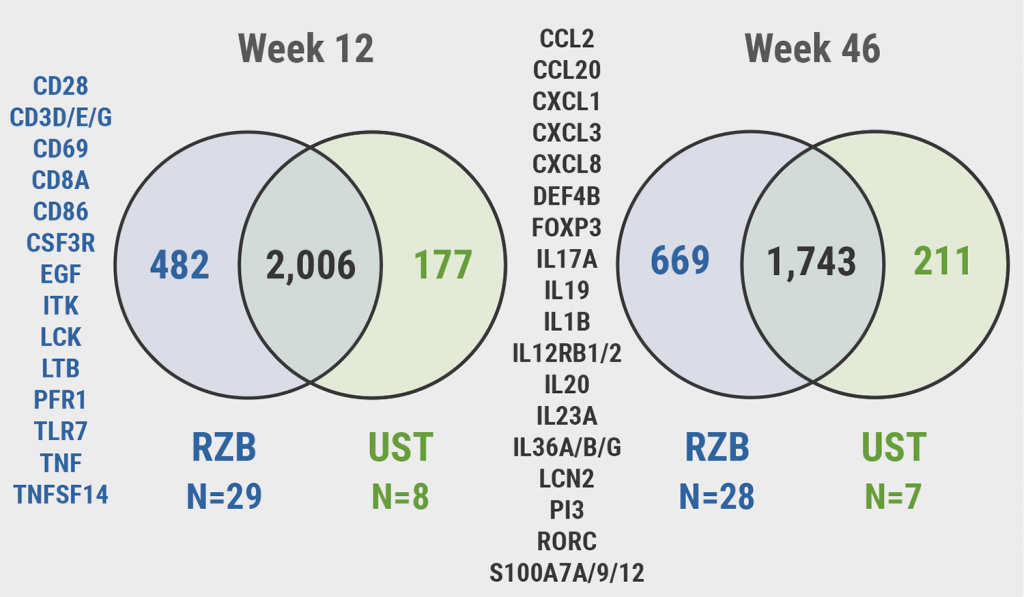Previously, the superior efficacy of the selective JAK inhibitor upadacitinib compared with dupilumab for the treatment of moderate-to-severe AD was demonstrated in the phase 3b, randomised Heads Up study (NCT03738397) [1]. The primary study endpoint was the proportion of patients that achieved an improvement in the Eczema Area and Severity Index (EASI) by 75% from baseline at week 16. Participants were randomised 1:1 to receive either oral upadacitinib 30 mg once daily (with a placebo prefilled syringe every other week) or subcutaneous dupilumab 300 mg every other week (with an oral placebo tablet once daily after a 600 mg loading dose at baseline). In the current analysis, presented by Prof. Jonathan Silverberg (George Washington University School of Medicine, Washington DC, USA), skin improvement was compared between upadacitinib and dupilumab using the proportions of patients who achieved improvement on the EASI score from baseline by ≥50%, ≥75%, ≥90%, and ≥100% [2].
A total of 692 participants could be included in this analysis. At week 16, a greater proportion of patients achieved skin improvements with upadacitinib than with dupilumab for each EASI category (see Figure). The difference in the proportion of patients that achieved complete skin clearance was particularly pronounced: 27.9% of patients treated with the JAK inhibitor achieved a ≥100% improvement in the EASI score compared with 7.6% treated with dupilumab (P<0.01). EASI improvements among dupilumab-treated patients were numerically greater at week 24. However, the total proportion of patients who achieved incrementally greater skin improvement levels with dupilumab was still 28.1% lower relative to upadacitinib.
Prof. Silverberg concluded that achieving substantial levels of skin improvement with upadacitinib is likely to translate into improvements in the overall quality of life for patients with AD.
Figure: Greater EASI50, EASI75 EASI90, and EASI100 responses at week 16 with upadacitinib vs dupilumab (NRI-C) [2]

*P<0.05; **P<0.01; ***P<0.001. EASI75/90/100 were multiplicity-controlled endpoints; EASI50 was a post-hoc analysis. DUPI, dupilumab; EASI, Eczema Area and Severity Index; NRI-C, non-responder imputation incorporating multiple imputations to handle missing data due to COVID-19; QD, once daily; Q2W, once every 2 weeks; UPA, upadacitinib.
- Blauvelt A, et al. JAMA Dermatol. 2021;157(9):1047–1055.
- Silverberg, J et al. Achieving incrementally greater skin improvement thresholds with upadacitinib vs dupilumab in moderate-to-severe atopic dermatitis: Heads Up study results. P34599, AAD 2022 Annual Meeting, 25–29 March, Boston, MA, USA.
Copyright ©2022 Medicom Medical Publishers
Posted on
Previous Article
« Dermatology diseases need the highest doses of biologics Next Article
Letter from the Editor »
« Dermatology diseases need the highest doses of biologics Next Article
Letter from the Editor »
Table of Contents: AAD 2022
Featured articles
Letter from the Editor
Lebrikizumab treatment leads to encouraging outcomes in multiple traits of AD
New Developments and Unmet Needs in Dermatology
Light at the end of the tunnel for vitiligo therapy
Intestinal microbe-preparation: Modest activity but safe for mild psoriasis
Alopecia areata: 1-year baricitinib treatment increases success
New anticholinergic preparation is effective and tolerable in hyperhidrosis
What’s Hot in Rare Diseases
Add-on apremilast may improve recalcitrant dermatomyositis
Could dupilumab put an end to the therapeutic draught in prurigo nodularis?
Fungal skin infections in children: A diagnosis to keep in mind
Innovative gel speeds up clearance of molluscum contagiosum lesions
JAK inhibition offers promising treatment prospects for uncommon dermatoses
JAK inhibitors may offer a new horizon in the treatment of sarcoidosis
Psoriasis: State of the Art
New insights into psoriasis comorbidity
Long-term psoriasis treatment with bimekizumab results in maintained efficacy
Novel developments in topical psoriasis therapy
Atopic Dermatitis: Novel Agents Enter the Stage
JAK inhibitors in AD: Setting the efficacy bar even higher
Lebrikizumab treatment leads to encouraging outcomes in multiple traits of AD
Novel IL-4/IL-13 blocker shows high efficacy with only modest conjunctivitis signal
Posters
Inpatient dermatologic therapy is linked to lower mortality and readmission rates
AD treatment during the pandemic: dupilumab does not raise COVID-19 infection risk
Upadacitinib: Fast and more pronounced skin improvement in AD patients
Dermatology diseases need the highest doses of biologics
Related Articles

February 2, 2022
Risankizumab superior to ustekinumab in skin histopathology scores
© 2024 Medicom Medical Publishers. All rights reserved. Terms and Conditions | Privacy Policy

